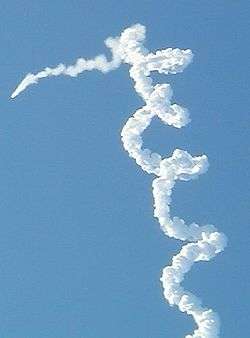Suzaku (satellite)
Suzaku (formerly ASTRO-EII) was an X-ray astronomy satellite developed jointly by the Institute of Space and Aeronautical Science at JAXA and NASA's Goddard Space Flight Center to probe high energy X-ray sources, such as supernova explosions, black holes and galactic clusters. It was launched on 10 July 2005 aboard the M-V rocket on the M-V-6 mission. After its successful launch, the satellite was renamed Suzaku after the mythical Vermilion bird of the South.[4]
 A picture of a fully integrated Astro-E2 before vibration tests at ISAS/JAXA. | |
| Mission type | Astronomy |
|---|---|
| Operator | JAXA / NASA |
| COSPAR ID | 2005-025A |
| SATCAT no. | 28773 |
| Website | www |
| Mission duration | Planned: 2 years Actual: 10 years, 1 month, 23 days |
| Spacecraft properties | |
| Manufacturer | Toshiba[1] |
| Launch mass | 1,706 kilograms (3,761 lb)[2] |
| Start of mission | |
| Launch date | 2005-07-10, 03:30:00 UTC |
| Rocket | M-V |
| Launch site | Uchinoura Space Center Uchinoura, Kagoshima, Japan |
| End of mission | |
| Decay date | no earlier than 2020[3] |
| Orbital parameters | |
| Reference system | Geocentric |
| Regime | Low Earth |
| Perigee altitude | 550 kilometres (340 mi) |
| Apogee altitude | 550 kilometres (340 mi) |
| Inclination | 31 degrees |
| Period | 96 minute |
| Main telescope | |
| Wavelengths | X-ray |
 The M-V rocket carrying ASTRO-E veering off course after launch on 10 February 2000. | |
| Operator | Institute of Space and Astronautical Science (ISAS) |
|---|---|
| COSPAR ID | 2005-025A |
| SATCAT no. | 28773 |
| Start of mission | |
| Launch date | 01:30:00, February 10, 2000 (UTC) |
| Rocket | M-V |
| Launch site | Kagoshima Space Center |
Just weeks after launch, on 29 July 2005 the first of a series of cooling system malfunctions occurred. These ultimately caused the entire reservoir of liquid helium to boil off into space by 8 August 2005. This effectively shut down the X-ray Spectrometer (XRS), which was the spacecraft's primary instrument. The two other instruments, the X-ray Imaging Spectrometer (XIS) and the Hard X-ray Detector (HXD), were unaffected by the malfunction. As a result, another XRS was integrated into the Hitomi X-ray satellite, launched in 2016.
On 26 August 2015, JAXA announced that communications with Suzaku had been intermittent since 1 June, and that the resumption of scientific operations would be difficult to accomplish given the spacecraft's condition.[5] Mission operators decided to complete the mission imminently, as Suzaku had exceeded its design lifespan by eight years at this point. The mission came to an end on 2 September 2015, when JAXA commanded the radio transmitters on Suzaku to switch themselves off.[3][6]
Spacecraft instruments
Suzaku carried high spectroscopic resolution, very wide energy band instruments for detecting signals ranging from soft X-rays up to gamma-rays (0.3–600 keV). High resolution spectroscopy and wide-band are essential factors to physically investigate high energy astronomical phenomena, such as black holes and supernovae. One such feature, the broad iron K line, may be key to more direct imaging of black holes.
- X-ray Telescope (XRT)
- X-ray Spectrometer (XRS)
- X-ray Imaging Spectrometer (XIS)
- Hard X-ray Detector (HXD)
- X-ray Telescope (XRT)
 Hard X-ray Detector (HXD)
Hard X-ray Detector (HXD) X-ray Imaging Spectrometer (XIS)
X-ray Imaging Spectrometer (XIS) X-ray Spectrometer (XRS)
X-ray Spectrometer (XRS)
ASTRO-E
Suzaku was a replacement for ASTRO-E, which was lost in a launch failure. The M-V carrier rocket on the M-V-4 mission launched on 10 February 2000 at 01:30:00 UTC but experienced a failure 42 seconds later, failing to achieve orbit and crashing with its payload into the ocean.[8]
Results
Suzaku discovered "fossil" light from a supernova remnant.[9]
References
- "Encyclopedia Astronautica - Toshiba". astronautix.com. Retrieved 9 September 2015.
- Kazuhisa Mitsuda; et al. (25 January 2007). "The X-Ray Observatory Suzaku". Publ. Astron. Soc. Jpn. 59 (SP1): S1–S7. arXiv:astro-ph/0608100. Bibcode:2007PASJ...59....1T. doi:10.1093/pasj/59.1.1. Retrieved 4 October 2010.
- Stephen Clark (4 September 2015). "Japanese X-ray observatory completes decade-long mission". Spaceflight Now. Retrieved 9 September 2015.
- すざく(朱雀、Suzaku) 命名の理由, JAXA
- "X-ray Astronomy Satellite "Suzaku" Completes Scientific Mission". National Research and Development Agency (JAXA). 26 August 2015. Retrieved 9 September 2015.
- "Suzaku Mission Declared Complete". Goddard Space Flight Center. 28 August 2015. Retrieved 4 September 2015.
- Tadayuki Takahashi; et al. (25 January 2007). "Hard X-ray Detector (HXD) on Board Suzaku". Publ. Astron. Soc. Jpn. 59 (SP1): S23–S33. Retrieved 4 October 2010.
- Kevin Boyce (2005). "ASTRO-E Launch". NASA Goddard Space Flight Center. Retrieved 2 March 2010.
- Suzaku Finds "Fossil" Fireballs from Supernovae 12.30.09
Further reading
- Special Issue: First Results from Suzaku. Publications of the Astronomical Society of Japan. Vol. 59, No. SP1. January 30, 2007. Retrieved 4 October 2010.
External links
- X-ray Astronomy Satellite "Suzaku" (ASTRO-EII) (JAXA)
- JAXA/ISAS Suzaku (ASTRO-EII) mission overview
- JAXA/ISAS Suzaku Information for Researchers
- JAXA report presentation of failure analysis of XRS (in Japanese)
- NASA Astronomy Picture of the Day: Launch of the Red Bird (12 July 2005)
- NASA ASTRO-EII mission description
- NASA/GSFC Suzaku Learning Center
- NASA/GSFC XRS-2 project page
.png)